Thursday, January 27, 2011
List Of Keyword Tools-Spice up your Keyword Research
1. Google Adwords Keyword Tool
This is one of the most popular and also free keyword tool available online right now, many webmasters do feel its enough just to make use of this tool alone for their keyword research process. Many do feel its the most authentic keyword tool available as the datas directly come from one of the most popular search engine that is Google itself.
2. Alexa
Although alexa is not a typical keyword research tool, but it does provide more less accurate details about the site and what keywords drive majority of the traffic for a particular site, this data can be quite useful when you want to analyze your competition and where it is getting its valuable hits from, thus making this tool invaluable for research purposes.
3. Compete
Compete is again a tool more similar to alexa, but its been said that compete gives more accurate details about a site over alexa. But just know that no tools can give really accurate data about a site, but most tools strive to achieve the near accuracy area and compete really stands out of the crowd by providing valuable data about a site which includes the terms which a particular site ranks on top which makes a site popular. You still get very limited information about the keywords on free version, if you want to expand your list then you need to pay for the pro version.
4. Keywordspy
Keyword spy is more like compete but this tool gives more in depth details in to your competitors, also gives you details about your PPC competitors, one of the best keyword tools out there, if you haven’t tried it before I highly recommend checking this tool out.
5. Spyfu
Spyfu gives you very good idea about your keywords you want to focus on, information about who are ranking well for your keywords already, stats for domains which are using PPC for your keywords. But one limitation with this tool is that it gives you only information from the data collected from US and UK, if you are focusing on market outside of UK and US this tool might not be very useful for you.
6. Wordtracker
Perhaps the second popular keyword tool out there after Google, unlike Google the datas of this keyword tool is collected from search engines like dogpile cannot be said that it gives very accurate datas about search volume but its been said it gives more or less accurate results for keywords. Again it comes in both paid and free version. You can opt for a paid version if you want additional functionality and more indepth keyword research.
White hat versus black hat
SEO techniques are classified by some into two broad categories: techniques that search engines recommend as part of good design, and those techniques that search engines do not approve of and attempt to minimize the effect of, referred to as spamdexing. Some industry commentators classify these methods, and the practitioners who employ them, as either white hat SEO, or black hat SEO.White hats tend to produce results that last a long time, whereas black hats anticipate that their sites will eventually be banned once the search engines discover what they are doing.
A SEO tactic, technique or method is considered white hat if it conforms to the search engines' guidelines and involves no deception. As the search engine guidelines are not written as a series of rules or commandments, this is an important distinction to note. White hat SEO is not just about following guidelines, but is about ensuring that the content a search engine indexes and subsequently ranks is the same content a user will see.
White hat advice is generally summed up as creating content for users, not for search engines, and then making that content easily accessible to the spiders, rather than attempting to game the algorithm. White hat SEO is in many ways similar to web development that promotes accessibility, although the two are not identical.
White Hat SEO is merely effective marketing, making efforts to deliver quality content to an audience that has requested the quality content. Traditional marketing means have allowed this through transparency and exposure. A search engine's algorithm takes this into account, such as Google's PageRank.
Black hat SEO attempts to improve rankings in ways that are disapproved of by the search engines, or involve deception. One black hat technique uses text that is hidden, either as text colored similar to the background, in an invisible div, or positioned off screen. Another method gives a different page depending on whether the page is being requested by a human visitor or a search engine, a technique known as cloaking.
Search engines may penalize sites they discover using black hat methods, either by reducing their rankings or eliminating their listings from their databases altogether. Such penalties can be applied either automatically by the search engines' algorithms, or by a manual site review. One infamous example was the February 2006 Google removal of both BMW Germany and Ricoh Germany for use of deceptive practices.Both companies, however, quickly apologized, fixed the offending pages, and were restored to Google's list
Wednesday, January 19, 2011
How to use Twitter For Business
Twitter is a wonderful business tool, not least because it's free; all it will cost is your time (and if that's in short supply, you can hire a social media marketer to manage it for you).
Used well, Twitter can provide good exposure for your business; but you can also damage your brand with social media marketing if you're not careful, so it's worth learning the biggest dos and don'ts before you start using Twitter.
Tip 1: Be yourself and be human
The beauty of Twitter is that it's a huge global community of human beings (mostly; there are spammer accounts but they're easy to spot, block and report). So do show your human side, especially when using your business account. Talk about things that matter to you: funny things your children say, recent achievements, your favourite band or TV show, and so on. Join in with conversations that interest you - be friendly, show emotion, and use smilies if you want to.
On the other hand, don't be too human. Don't share anything you wouldn't share at a real-world business networking event; keep intimate health problems and controversial or potentially offensive opinions to yourself.
Tip 2: Watch how you write
Some people write well, others don't - that's true in all areas of life, not just on Twitter. You don't need to be a bestselling novelist to use Twitter, but it helps if you have basic literacy skills (and if you use Twitter at the website instead of through a client, your Tweets will be spellchecked as you type anyway - which helps).
Tip 1: Be yourself and be human
The beauty of Twitter is that it's a huge global community of human beings (mostly; there are spammer accounts but they're easy to spot, block and report). So do show your human side, especially when using your business account. Talk about things that matter to you: funny things your children say, recent achievements, your favourite band or TV show, and so on. Join in with conversations that interest you - be friendly, show emotion, and use smilies if you want to.
On the other hand, don't be too human. Don't share anything you wouldn't share at a real-world business networking event; keep intimate health problems and controversial or potentially offensive opinions to yourself.
Tip 2: Watch how you write
Some people write well, others don't - that's true in all areas of life, not just on Twitter. You don't need to be a bestselling novelist to use Twitter, but it helps if you have basic literacy skills (and if you use Twitter at the website instead of through a client, your Tweets will be spellchecked as you type anyway - which helps).
However good (or bad) your writing skills are, with Twitter's 140-character limit you'll need to be creative with your Tweets. Your Tweets need to be concise yet informative, and often you'll be trying to squeeze in a URL too (URL shortening services like bit.ly and tinyurl.com are lifesavers).
One definite don't is using text speak. Text speak is fine if you're 13, but as a professional adult promoting your business you're just going to look silly, and won't communicate your messages efficiently - unless you're targeting 13 year olds.
Tip 3: Share and share alike
If you have some good news - related to your business or your personal life - share it; everybody loves a good news story.
Do share links - to your website, your blog, your local news service, or anything else that interests your followers - this is a great way to get conversations going. But do remember to explain what the link's about, or your followers will feel less inclined to click it. And don't Tweet the same link over and over; people will quickly become bored and may stop following you.
Do retweet your friends' links, too; they'll be grateful, and so will your followers if the link is interesting and relevant. But here's a very big 'do' - DO make sure you click the link and read the content before sharing it with your followers, or you could end up sharing a page that's irrelevant or offensive, or which contradicts your usual position on the subject.
Tip 4: Be part of the community
Don't treat Twitter as your personal billboard. It's not: it's a community, millions of members strong, and the community as a whole is not very tolerant of users who constantly advertise. Try to stick to the 80-20 rule when you use Twitter for business: no more than 20% of your Tweets should advertise or self-promote, and at least 80% should be non-promotional. If you can get the ratio down to 90-10 or 95-5, even better.
One definite don't is using text speak. Text speak is fine if you're 13, but as a professional adult promoting your business you're just going to look silly, and won't communicate your messages efficiently - unless you're targeting 13 year olds.
Tip 3: Share and share alike
If you have some good news - related to your business or your personal life - share it; everybody loves a good news story.
Do share links - to your website, your blog, your local news service, or anything else that interests your followers - this is a great way to get conversations going. But do remember to explain what the link's about, or your followers will feel less inclined to click it. And don't Tweet the same link over and over; people will quickly become bored and may stop following you.
Do retweet your friends' links, too; they'll be grateful, and so will your followers if the link is interesting and relevant. But here's a very big 'do' - DO make sure you click the link and read the content before sharing it with your followers, or you could end up sharing a page that's irrelevant or offensive, or which contradicts your usual position on the subject.
Tip 4: Be part of the community
Don't treat Twitter as your personal billboard. It's not: it's a community, millions of members strong, and the community as a whole is not very tolerant of users who constantly advertise. Try to stick to the 80-20 rule when you use Twitter for business: no more than 20% of your Tweets should advertise or self-promote, and at least 80% should be non-promotional. If you can get the ratio down to 90-10 or 95-5, even better.
Listen to what people are saying, and join in. Twitter is a network of conversations, so it's good practice to listen and respond to parts of those conversations that interest you; don't just stand in the middle of the room with a megaphone, shouting "I'm fabulous! I'm selling widgets at 20% off this week!" Again - if you wouldn't do it at a business networking event, don't do it on Twitter.
Do re tweet your friends' requests for help (for example, charity appeals and sponsorship requests), and do introduce friends that are new to Twitter and could do with some followers. And again - do re tweet useful, interesting links from people you follow, but always check links before sending.
Tip 5: Mind your language
Don't use offensive language when representing your business on Twitter; even mild swearwords can put sensitive souls off following you (and besides - cursing in public is hardly professional).
Use Twitter to answer customer questions and solve their problems, by all means; many organizations use Twitter as a customer services tool very effectively. But never, ever use an impolite or impatient tone with a customer. On Twitter, everything you say is out there for everyone to see, so leave your followers with the best possible impression of your brand at all times... the Internet has a very long memory!
Finally - consider this a bonus tip, since it's not really connected to any of the previous ones - try to enjoy yourself when you use Twitter. Try to embrace all that's good about Twitter - the new friendships and business contacts you'll make, the fun hashtags and trending topics, the strong community spirit - and before long you'll be singing (or is that Tweeting?) Twitter's praises to anyone who'll listen.
Do re tweet your friends' requests for help (for example, charity appeals and sponsorship requests), and do introduce friends that are new to Twitter and could do with some followers. And again - do re tweet useful, interesting links from people you follow, but always check links before sending.
Tip 5: Mind your language
Don't use offensive language when representing your business on Twitter; even mild swearwords can put sensitive souls off following you (and besides - cursing in public is hardly professional).
Use Twitter to answer customer questions and solve their problems, by all means; many organizations use Twitter as a customer services tool very effectively. But never, ever use an impolite or impatient tone with a customer. On Twitter, everything you say is out there for everyone to see, so leave your followers with the best possible impression of your brand at all times... the Internet has a very long memory!
Finally - consider this a bonus tip, since it's not really connected to any of the previous ones - try to enjoy yourself when you use Twitter. Try to embrace all that's good about Twitter - the new friendships and business contacts you'll make, the fun hashtags and trending topics, the strong community spirit - and before long you'll be singing (or is that Tweeting?) Twitter's praises to anyone who'll listen.
Monday, January 10, 2011
The Distribution of PageRank Regarding Search Engine Optimisation
Up to this point, it has been described how the number of pages and the number of inbound and outbound links, respectively, influence PageRank. Here, it will mainly be discussed in how far PageRank can be affected for the purpose of search engine optimisation by a website's internal linking structure.
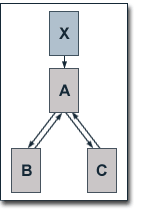
In most cases, websites are hierachically structured to a certain extend, as it is illustrated in our example of a web site consisting of the pages A, B and C. Normally, the root page is withal optimised for the most important search phrase. In our example, the optimised page A has an external inbound link from page X which has no other outbound links and a PageRank of 10. The pages B and C each receive a link from page A and link back to it. If we set the damping factor d to 0.5 the equations for the single pages' PageRank values are given by
PR(A) = 0.5 + 0.5 (10 + PR(B) + PR (C))
PR(B) = 0.5 + 0.5 (PR(A) / 2)
PR(C) = 0.5 + 0.5 (PR(A) / 2)
PR(B) = 0.5 + 0.5 (PR(A) / 2)
PR(C) = 0.5 + 0.5 (PR(A) / 2)
Solving the equations gives us the follwing PageRank values:
PR(A) = 8
PR(B) = 2.5
PR(C) = 2.5
PR(B) = 2.5
PR(C) = 2.5
It is generally not advisable to solely work on the root page of a site for the purpose of search engine optimisation. Indeed, it is, in most cases, more reasonable to optimise each page of a site for different search phrases.
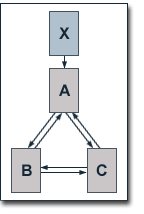
We now assume that the root page of our example website provides satisfactory results for its search phrase, but the other pages of the site do not, and therefore we modify the linking structure of the website. We add links from page B to page C and vice versa to our formerly hierarchically structured example site. Again, page A has an external inbound link from page X which has no other outbound links and a PageRank of 10. At a damping factor d of 0.5, the equations for the single pages' PageRank values are given by
PR(A) = 0.5 + 0.5 (10 + PR(B) / 2 + PR(C) / 2)
PR(B) = 0.5 + 0.5 (PR(A) / 2 + PR(C) / 2)
PR(C) = 0.5 + 0.5 (PR(A) / 2 + PR(B) / 2)
PR(B) = 0.5 + 0.5 (PR(A) / 2 + PR(C) / 2)
PR(C) = 0.5 + 0.5 (PR(A) / 2 + PR(B) / 2)
Solving the equations gives us the follwing PageRank values:
PR(A) = 7
PR(B) = 3
PR(C) = 3
PR(B) = 3
PR(C) = 3
The result of adding internal links is an increase of the PageRank values of pages B and C, so that they likely will rise in search engine result pages for their targeted keywords. On the other hand, of course, page A will likely rank lower because of its diminished PageRank.
Generally spoken, PageRank will distribute for the purpose of search engine optimisation more equally among the pages of a site, the more the hierarchically lower pages are interlinked.
Well Directed PageRank Distribution by Concentration of Outbound Links
It has already been demonstrated that external outbound links tend to have negative effects on the PageRank of a website's web pages. Here, it shall be illustrated how this effect can be reduced for the purpose of search engine optimisation by the systematic arrangement of external outbound links.
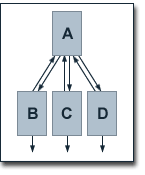
We take a look at another hierarchically structured example site consisting of the pages A, B, C and D. Page A has links to the pages B, C and D. Besides a link back to page A, each of the pages B, C and D has one external outbound link. None of those external pages which receive links from the pages B, C and D link back to our example site. If we assume a damping factor d of 0.5, the equations for the calculation of the single pages' PageRank values are given by
PR(A) = 0.5 + 0.5 (PR(B) / 2 + PR(C) / 2 + PR(D) / 2)
PR(B) = PR(C) = PR(D) = 0.5 + 0.5 (PR(A) / 3)
PR(B) = PR(C) = PR(D) = 0.5 + 0.5 (PR(A) / 3)
Solving the equations gives us the follwing PageRank values:
PR(A) = 1
PR(B) = 2/3
PR(C) = 2/3
PR(D) = 2/3
PR(B) = 2/3
PR(C) = 2/3
PR(D) = 2/3
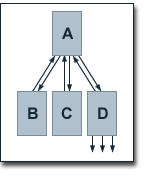
Now, we modify our example site in a way that page D has all three external outbound links while pages B and C have no more external outbound links. Besides this, the general conditions of our example stay the same as above. None of the external pages which receive a link from pages D link back to our example site. If we, again, assume a damping factor d of 0.5, the equations for the calculations of the single pages' PageRank values are given by
PR(A) = 0.5 + 0.5 (PR(B) + PR(C) + PR(D) / 4)
PR(B) = PR(C) = PR(D) = 0.5 + 0.5 (PR(A) / 3)
PR(B) = PR(C) = PR(D) = 0.5 + 0.5 (PR(A) / 3)
Solving these equations gives us the follwing PageRank values:
PR(A) = 17/13
PR(B) = 28/39
PR(C) = 28/39
PR(D) = 28/39
PR(B) = 28/39
PR(C) = 28/39
PR(D) = 28/39
As a result of our modifications, we see that the PageRank values for each single page of our site have increased. Regarding search engine optimisation, it is therefore advisable to concentrate external outbound links on as few pages as possible, as long as it does not lessen a site's usabilty.
Link Exchanges for the purpose of Search Engine Optimisation
For the purpose of search engine optimisation, many webmasters exchange links with others to increase link popularity. As it has already been shown, adding links within closed systems of web pages has no effects on the accumulated PageRank of those pages. So, it is questionable if link exchanges have positive consequences in terms of PageRank at all.
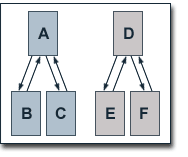
To show the effects of link exchanges, we take a look at an an example of two hierarchically structured websites consisting of pages A, B and C and D, E and F, respectively. Within the first site, page A links to pages B and C and those link back to page A. The second site is structured accordingly, so that the PageRank values for its pages do not have to be computed explicitly. At a damping factor d of 0.5, the equations for the single pages' PageRank values are given by
PR(A) = 0.5 + 0.5 (PR(B) + PR(C))
PR(B) = PR(C) = 0.5 + 0.5 (PR(A) / 2)
PR(B) = PR(C) = 0.5 + 0.5 (PR(A) / 2)
Solving the equations gives us the follwing PageRank values for the first site
PR(A) = 4/3
PR(B) = 5/6
PR(C) = 5/6
PR(B) = 5/6
PR(C) = 5/6
and accordingly for the second site
PR(D) = 4/3
PR(E) = 5/6
PR(F) = 5/6
PR(E) = 5/6
PR(F) = 5/6
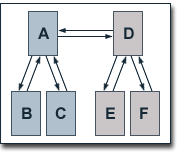
Now, two pages of our example sites start a link exchange. Page A links to page D and vice versa. If we leave the general conditions of our example the same as above and, again, set the damping factor d to 0.5, the equations for the calculations of the single pages' PageRank values are given by
PR(A) = 0.5 + 0.5 (PR(B) + PR(C) + PR(D) / 3)
PR(B) = PR(C) = 0.5 + 0.5 (PR(A) / 3)
PR(D) = 0.5 + 0.5 (PR(E) + PR(F) + PR(A) / 3)
PR(E) = PR(F) = 0.5 + 0.5 (PR(D) / 3)
PR(B) = PR(C) = 0.5 + 0.5 (PR(A) / 3)
PR(D) = 0.5 + 0.5 (PR(E) + PR(F) + PR(A) / 3)
PR(E) = PR(F) = 0.5 + 0.5 (PR(D) / 3)
Solving these equations gives us the follwing PageRank values:
PR(A) = 3/2
PR(B) = 3/4
PR(C) = 3/4
PR(D) = 3/2
PR(E) = 3/4
PR(F) = 3/4
PR(B) = 3/4
PR(C) = 3/4
PR(D) = 3/2
PR(E) = 3/4
PR(F) = 3/4
We see that the link exchange makes pages A and D benefit in terms of PageRank while all other pages lose PageRank. Regarding search engine optimisation, this means that the exactly opposite effect compared to interlinking hierachically lower pages internally takes place. A link exchange is thus advisable, if one page (e.g. the root page of a site) shall be optimised for one important key phrase.
A basic premise for the positive effects of a link exchange is that both involved pages propagate a similar amount of PageRank to each other. If one of the involved pages has a significantly higher PageRank or fewer outbound links, it is likely that all of its site's pages lose PageRank. Here, an important influencing factor is the size of a site. The more pages a web site has, the more PageRank from an inbound link is distributed to other pages of the site, regardless of the number of outbound links on the page that is involved in the link exchange. This way, the page involved in a link exchange itself benefits lesser from the link exchange and cannot propagate as much PageRank to the other page involved in the link exchange. All the influencing factors should be weighted up against each other bevor one trades links.
Finally, it shall be noted that it is possible that all pages of a site benefit from a link exchange in terms of PageRank, whereby also the other site taking part in the link exchange does not lose PageRank. This may occur, when the page involved in the link exchange already has a certain number of external outbound links which don't link back to that site. In this case, less PageRank is lost by the already existing outbound links.
The Effect of the Number of Pages
Since the accumulated PageRank of all pages of the web equals the total number of web pages, it follows directly that an additional web page increases the added up PageRank for all pages of the web by one. But far more interesting than the effect on the added up PageRank of the web is the impact of additional pages on the PageRank of actual websites.
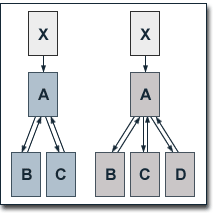
To illustrate the effects of addional web pages, we take a look at a hierachically structured web site consisting of three pages A, B and C, which are joined by an additional page D on the hierarchically lower level of the site. The site has no outbound links. A link from page X which has no other outbound links and a PageRank of 10 points to page A. At a damping factor d of 0.75, the equations for the single pages' PageRank values before adding page D are given by
PR(A) = 0.25 + 0.75 (10 + PR(B) + PR(C))
PR(B) = PR(C) = 0.25 + 0.75 (PR(A) / 2)
PR(B) = PR(C) = 0.25 + 0.75 (PR(A) / 2)
Solving the equations gives us the follwing PageRank values:
PR(A) = 260/14
PR(B) = 101/14
PR(C) = 101/14
PR(B) = 101/14
PR(C) = 101/14
After adding page D, the equations for the pages' PageRank values are given by
PR(A) = 0.25 + 0.75 (10 + PR(B) + PR(C) + PR(D))
PR(B) = PR(C) = PR(D) = 0.25 + 0.75 (PR(A) / 3)
PR(B) = PR(C) = PR(D) = 0.25 + 0.75 (PR(A) / 3)
Solving these equations gives us the follwing PageRank values:
PR(A) = 266/14
PR(B) = 70/14
PR(C) = 70/14
PR(D) = 70/14
PR(B) = 70/14
PR(C) = 70/14
PR(D) = 70/14
As to be expected since our example site has no outbound links, after adding page D, the accumulated PageRank of all pages increases by one from 33 to 34. Further, the PageRank of page A rises marginally. In contrast, the PageRank of pages B and C depletes substantially.
The Reduction of PageRank by Additional Pages
By adding pages to a hierarchically structured websites, the consequences for the already existing pages are nonuniform. The consequences for websites with a different structure shall be shown by another example.
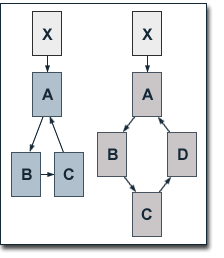
We take a look at a website constisting of three pages A, B and C which are linked to each other in circle. The pages are then joined by page D which fits into the circular linking structure. The regarded site has no outbound links. Again, a link from page X which has no other outbound links and a PageRank of 10 points to page A. At a damping factor d of 0.75, the equations for the single pages' PageRank values before adding page D are given by
PR(A) = 0.25 + 0.75 (10 + PR(C))
PR(B) = 0.25 + 0.75 × PR(A)
PR(C) = 0.25 + 0.75 × PR(B)
PR(B) = 0.25 + 0.75 × PR(A)
PR(C) = 0.25 + 0.75 × PR(B)
Solving the equations gives us the follwing PageRank values:
PR(A) = 517/37 = 13.97
PR(B) = 397/37 = 10.73
PR(C) = 307/37 = 8.30
PR(B) = 397/37 = 10.73
PR(C) = 307/37 = 8.30
After adding page D, the equations for the pages' PageRank values are given by
PR(A) = 0.25 + 0.75 (10 + PR(D))
PR(B) = 0.25 + 0.75 × PR(A)
PR(C) = 0.25 + 0.75 × PR(B)
PR(D) = 0.25 + 0.75 × PR(C)
PR(B) = 0.25 + 0.75 × PR(A)
PR(C) = 0.25 + 0.75 × PR(B)
PR(D) = 0.25 + 0.75 × PR(C)
Solving these equations gives us the follwing PageRank values:
PR(A) = 419/35 = 11.97
PR(B) = 323/35 = 9.23
PR(C) = 251/35 = 7.17
PR(D) = 197/35 = 5.63
PR(B) = 323/35 = 9.23
PR(C) = 251/35 = 7.17
PR(D) = 197/35 = 5.63
Again, after adding page D, the accumulated PageRank of all pages increases by one from 33 to 34. But now, any of the pages which already existed before page D was added lose PageRank. The more uniform PageRank is distributed by the links within a site, the more likely will this effect occur.
Since adding pages to a site often reduces PageRank for already existing pages, it becomes obvious that the PageRank algorithm tends to privilege smaller web sites. Indeed, bigger web sites can counterbalance this effect by being more attractive for other webmasters to link to them, simply because they have more content.
None the less, it is also possible to increase the PageRank of existing pages by additional pages. Therefore, it has to be considered that as few PageRank as possible is distributed to these additional pages.
The Effect of Outbound Links on PageRank
Since PageRank is based on the linking structure of the whole web, it is inescapable that if the inbound links of a page influence its PageRank, its outbound links do also have some impact. To illustrate the effects of outbound links, we take a look at a simple example.
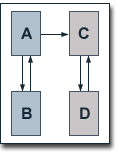
We regard a web consisting of to websites, each having two web pages. One site consists of pages A and B, the other constists of pages C and D. Initially, both pages of each site solely link to each other. It is obvious that each page then has a PageRank of one. Now we add a link which points from page A to page C. At a damping factor of 0.75, we therefore get the following equations for the single pages' PageRank values:
PR(A) = 0.25 + 0.75 PR(B)
PR(B) = 0.25 + 0.375 PR(A)
PR(C) = 0.25 + 0.75 PR(D) + 0.375 PR(A)
PR(D) = 0.25 + 0.75 PR(C)
PR(B) = 0.25 + 0.375 PR(A)
PR(C) = 0.25 + 0.75 PR(D) + 0.375 PR(A)
PR(D) = 0.25 + 0.75 PR(C)
Solving the equations gives us the following PageRank values for the first site:
PR(A) = 14/23
PR(B) = 11/23
PR(B) = 11/23
We therefore get an accumulated PageRank of 25/23 for the first site. The PageRank values of the second site are given by
PR(C) = 35/23
PR(D) = 32/23
PR(D) = 32/23
So, the accumulated PageRank of the second site is 67/23. The total PageRank for both sites is 92/23 = 4. Hence, adding a link has no effect on the total PageRank of the web. Additionally, the PageRank benefit for one site equals the PageRank loss of the other.
The Actual Effect of Outbound Links
As it has already been shown, the PageRank benefit for a closed system of web pages by an additional inbound link is given by
(d / (1-d)) × (PR(X) / C(X)),
where X is the linking page, PR(X) is its PageRank and C(X) is the number of its outbound links. Hence, this value also represents the PageRank loss of a formerly closed system of web pages, when a page X within this system of pages now points by a link to an external page.
The validity of the above formula requires that the page which receives the link from the formerly closed system of pages does not link back to that system, since it otherwise gains back some of the lost PageRank. Of course, this effect may also occur when not the page that receives the link from the formerly closed system of pages links back directly, but another page which has an inbound link from that page. Indeed, this effect may be disregarded because of the damping factor, if there are enough other web pages in-between the link-recursion. The validity of the formula also requires that the linking site has no other external outbound links. If it has other external outbound links, the loss of PageRank of the regarded site diminishes and the pages already receiving a link from that page lose PageRank accordingly.
Even if the actual PageRank values for the pages of an existing web site were known, it would not be possible to calculate to which extend an added outbound link diminishes the PageRank loss of the site, since the above presented formula regards the status after adding the link.
Intuitive Justification of the Effect of Outbound Links
The intuitive justification for the loss of PageRank by an additional external outbound link according to the Random Surfer Modell is that by adding an external outbound link to one page the surfer will less likely follow an internal link on that page. So, the probability for the surfer reaching other pages within a site diminishes. If those other pages of the site have links back to the page to which the external outbound link has been added, also this page's PageRank will deplete.
We can conclude that external outbound links diminish the totalized PageRank of a site and probably also the PageRank of each single page of a site. But, since links between web sites are the fundament of PageRank and indespensable for its functioning, there is the possibility that outbound links have positive effects within other parts of Google's ranking criteria. Lastly, relevant outbound links do constitute the quality of a web page and a webmaster who points to other pages integrates their content in some way into his own site.
Dangling Links
An important aspect of outbound links is the lack of them on web pages. When a web page has no outbound links, its PageRank cannot be distributed to other pages. Lawrence Page and Sergey Brin characterise links to those pages as dangling links.
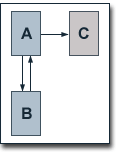
The effect of dangling links shall be illustrated by a small example website. We take a look at a site consisting of three pages A, B and C. In our example, the pages A and B link to each other. Additionally, page A links to page C. Page C itself has no outbound links to other pages. At a damping factor of 0.75, we get the following equations for the single pages' PageRank values:
PR(A) = 0.25 + 0.75 PR(B)
PR(B) = 0.25 + 0.375 PR(A)
PR(C) = 0.25 + 0.375 PR(A)
PR(B) = 0.25 + 0.375 PR(A)
PR(C) = 0.25 + 0.375 PR(A)
Solving the equations gives us the following PageRank values:
PR(A) = 14/23
PR(B) = 11/23
PR(C) = 11/23
PR(B) = 11/23
PR(C) = 11/23
So, the accumulated PageRank of all three pages is 36/23 which is just over half the value that we could have expected if page A had links to one of the other pages. According to Page and Brin, the number of dangling links in Google's index is fairly high. A reason therefore is that many linked pages are not indexed by Google, for example because indexing is disallowed by a robots.txt file. Additionally, Google meanwhile indexes several file types and not HTML only. PDF or Word files do not really have outbound links and, hence, dangling links could have major impacts on PageRank.
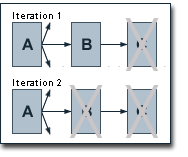
In order to prevent PageRank from the negative effects of dangling links, pages wihout outbound links have to be removed from the database until the PageRank values are computed. According to Page and Brin, the number of outbound links on pages with dangling links is thereby normalised. As shown in our illustration, removing one page can cause new dangling links and, hence, removing pages has to be an iterative process. After the PageRank calculation is finished, PageRank can be assigned to the formerly removed pages based on the PageRank algorithm. Therefore, as many iterations are needed as for removing the pages. Regarding our illustration, page C could be processed before page B. At that point, page B has no PageRank yet and, so, page C will not receive any either. Then, page B receives PageRank from page A and during the second iteration, also page C gets its PageRank.
Regarding our example website for dangling links, removing page C from the database results in page A and B each having a PageRank of 1. After the calculations, page C is assigned a PageRank of 0.25 + 0.375 PR(A) = 0.625. So, the accumulated PageRank does not equal the number of pages, but at least all pages which have outbound links are not harmed from the danging links problem.
By removing dangling links from the database, they do not have any negative effects on the PageRank of the rest of the web. Since PDF files are dangling links, links to PDF files do not diminish the PageRank of the linking page or site. So, PDF files can be a good means of search engine optimisation for Google.
The Effect of Inbound Links on PageRank
It has already been shown that each additional inbound link for a web page always increases that page's PageRank. Taking a look at the PageRank algorithm, which is given by
PR(A) = (1-d) + d (PR(T1)/C(T1) + ... + PR(Tn)/C(Tn))
one may assume that an additional inbound link from page X increases the PageRank of page A by
d × PR(X) / C(X)
where PR(X) is the PageRank of page X and C(X) is the total number of its outbound links. But page A usually links to other pages itself. Thus, these pages get a PageRank benefit also. If these pages link back to page A, page A will have an even higher PageRank benefit from its additional inbound link.
The single effects of additional inbound links shall be illustrated by an example.
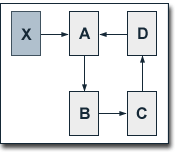
We regard a website consisting of four pages A, B, C and D which are linked to each other in circle. Without external inbound links to one of these pages, each of them obviously has a PageRank of 1. We now add a page X to our example, for which we presume a constant Pagerank PR(X) of 10. Further, page X links to page A by its only outbound link. Setting the damping factor d to 0.5, we get the following equations for the PageRank values of the single pages of our site:
PR(A) = 0.5 + 0.5 (PR(X) + PR(D)) = 5.5 + 0.5 PR(D)
PR(B) = 0.5 + 0.5 PR(A)
PR(C) = 0.5 + 0.5 PR(B)
PR(D) = 0.5 + 0.5 PR(C)
PR(B) = 0.5 + 0.5 PR(A)
PR(C) = 0.5 + 0.5 PR(B)
PR(D) = 0.5 + 0.5 PR(C)
Since the total number of outbound links for each page is one, the outbound links do not need to be considered in the equations. Solving them gives us the following PageRank values:
PR(A) = 19/3 = 6.33
PR(B) = 11/3 = 3.67
PR(C) = 7/3 = 2.33
PR(D) = 5/3 = 1.67
PR(B) = 11/3 = 3.67
PR(C) = 7/3 = 2.33
PR(D) = 5/3 = 1.67
We see that the initial effect of the additional inbound link of page A, which was given by
d × PR(X) / C(X) = 0,5 × 10 / 1 = 5
is passed on by the links on our site.
The Influence of the Damping Factor
The degree of PageRank propagation from one page to another by a link is primarily determined by the damping factor d. If we set d to 0.75 we get the following equations for our above example:
PR(A) = 0.25 + 0.75 (PR(X) + PR(D)) = 7.75 + 0.75 PR(D)
PR(B) = 0.25 + 0.75 PR(A)
PR(C) = 0.25 + 0.75 PR(B)
PR(D) = 0.25 + 0.75 PR(C)
PR(B) = 0.25 + 0.75 PR(A)
PR(C) = 0.25 + 0.75 PR(B)
PR(D) = 0.25 + 0.75 PR(C)
Solving these equations gives us the following PageRank values:
PR(A) = 419/35 = 11.97
PR(B) = 323/35 = 9.23
PR(C) = 251/35 = 7.17
PR(D) = 197/35 = 5.63
PR(B) = 323/35 = 9.23
PR(C) = 251/35 = 7.17
PR(D) = 197/35 = 5.63
First of all, we see that there is a significantly higher initial effect of additional inbound link for page A which is given by
d × PR(X) / C(X) = 0.75 × 10 / 1 = 7.5
This initial effect is then propagated even stronger by the links on our site. In this way, the PageRank of page A is almost twice as high at a damping factor of 0.75 than it is at a damping factor of 0.5. At a damping factor of 0.5 the PageRank of page A is almost four times superior to the PageRank of page D, while at a damping factor of 0.75 it is only a little more than twice as high. So, the higher the damping factor, the larger is the effect of an additional inbound link for the PageRank of the page that receives the link and the more evenly distributes PageRank over the other pages of a site.
The Actual Effect of Additional Inbound Links
At a damping factor of 0.5, the accumulated PageRank of all pages of our site is given by
PR(A) + PR(B) + PR(C) + PR(D) = 14
Hence, by a page with a PageRank of 10 linking to one page of our example site by its only outbound link, the accumulated PageRank of all pages of the site is increased by 10. (Before adding the link, each page has had a PageRank of 1.) At a damping factor of 0.75 the accumulated PageRank of all pages of the site is given by
PR(A) + PR(B) + PR(C) + PR(D) = 34
This time the accumulated PageRank increases by 30. The accumulated PageRank of all pages of a site always increases by
(d / (1-d)) × (PR(X) / C(X))
where X is a page additionally linking to one page of the site, PR(X) is its PageRank and C(X) its number of outbound links. The formula presented above is only valid, if the additional link points to a page within a closed system of pages, as, for instance, a website without outbound links to other sites. As far as the website has links pointing to external pages, the surplus for the site itself diminishes accordingly, because a part of the additional PageRank is propagated to external pages.
The justification of the above formula is given by Raph Levien and it is based on the Random Surfer Model. The walk length of the random surfer is an exponential distribution with a mean of (d/(1-d)). When the random surfer follows a link to a closed system of web pages, he visits on average (d/(1-d)) pages within that closed system. So, this much more PageRank of the linking page - weighted by the number of its outbound links - is distributed to the closed system.
For the actual PageRank calculations at Google, Lawrence Page und Sergey Brin claim to usually set the damping factor d to 0.85. Thereby, the boost for a closed system of web pages by an additional link from page X is given by
(0.85 / 0.15) × (PR(X) / C(X)) = 5.67 × (PR(X) / C(X))
So, inbound links have a far larger effect than one may assume.
The PageRank-1 Rule
Users of the Google Toolbar often notice that pages with a certain Toolbar PageRank have an inbound link from a page with a Toolbar PageRank which is higher by one. Some take this observation to doubt the validity of the PageRank algorithm presented here for the actual ranking methods of the Google search engine. It shall be shown, however, that the PageRank-1 rule complies with the PageRank algorithm.
Basically, the PageRank-1 rule proves the fundamental principle of PageRank. Web pages are important themselves if other important web pages link to them. It is not necessary for a page to have many inbound links to rank well. A single link from a high ranking page is sufficient.
To show the actual consistance of the PageRank-1 rule with the PageRank algorithm several factors have to be taken into consideration. First of all, the toolbar PageRank is a logarithmically scaled version of real PageRank values. If the PageRank value of one page is one higher than the PageRank value of another page in terms of Toolbar PageRank, than its real PageRank can at least be higher by an amount which equals the logarithmical basis for the scalation of Toolbar PageRank. If the logarithmical basis for the scalation is 6 and the toolbar PageRank of a linking Page is 5, then the real PageRank of the page which receives the link can be at least 6 times smaller to make that page still get a toolbar PageRank of 4.
However, the number of outbound links on the linking page thwarts the effect of the logarithmical basis, because the PageRank propagation from one page to another is devided by the number of outbound links on the linking page. But it has already been shown that the PageRank benefit by a link is higher than PageRank algorithm's term d(PR(Ti)/C(Ti)) pretends. The reason is that the PageRank benefit for one page is further distributed to other pages within the site. If those pages link back as it usualy happens, the PageRank benefit for the page which initially received the link is accordingly higher. If we assume that at a high damping factor the logarithmical basis for PageRank scalation is 6 and a page receives a PageRank benefit which is twice as high as the PageRank of the linking page devided by the number of its outbound links, the linking page could have at least 12 outbound links so that the Toolbar PageRank of the page receiving the link is still at most one lower than the toolbar PageRank of the linking page.
A number of 12 outbound links admittedly seems relatively small. But normally, if a page has an external inbound link, this is not the only one for that page. Most likely other pages link to that page and propagate PageRank to it. And if there are examples where a page receives a single link from another page and the PageRanks of both pages comply the PageRank-1 rule although the linking page has many outbound links, this is first of all an indication for the linking page's toolbar PageRank being at the upper end of its scale. The linking page could be a "high" 5 and the page receiving the link could be a "low" 4. In this way, the linking page could have up to 72 outbound links. This number rises accordingly if we assume a higher logarithmical basis for the scalation of Toolbar PageRank.
The Implementation of PageRank in the Google Search Engine
Regarding the implementation of PageRank, first of all, it is important how PageRank is integrated into the general ranking of web pages by the Google search engine. The proceedings have been described by Lawrencec Page and Sergey Brin in several publications. Initially, the ranking of web pages by the Google search engine was determined by three factors:
 | Page specific factors |
 | Anchor text of inbound links |
 | PageRank |
Page specific factors are, besides the body text, for instance the content of the title tag or the URL of the document. It is more than likely that since the publications of Page and Brin more factors have joined the ranking methods of the Google search engine. But this shall not be of interest here.
In order to provide search results, Google computes an IR score out of page specific factors and the anchor text of inbound links of a page, which is weighted by position and accentuation of the search term within the document. This way the relevance of a document for a query is determined. The IR-score is then combined with PageRank as an indicator for the general importance of the page. To combine the IR score with PageRank the two values are multiplicated. It is obvious that they cannot be added, since otherwise pages with a very high PageRank would rank high in search results even if the page is not related to the search query.
Especially for queries consisting of two or more search terms, there is a far bigger influence of the content related ranking criteria, whereas the impact of PageRank is mainly visible for unspecific single word queries. If webmasters target search phrases of two or more words it is possible for them to achieve better rankings than pages with high PageRank by means of classical search engine optimisation.
If pages are optimised for highly competitive search terms, it is essential for good rankings to have a high PageRank, even if a page is well optimised in terms of classical search engine optimisation. The reason therefore is that the increase of IR score deminishes the more often the keyword occurs within the document or the anchor texts of inbound links to avoid spam by extensive keyword repetition. Thereby, the potentialities of classical search engine optimisation are limited and PageRank becomes the decisive factor in highly competitive areas.
The PageRank Display of the Google Toolbar
PageRank became widely known by the PageRank display of the Google Toolbar. The Google Toolbar is a browser plug-in for Microsoft Internet Explorer which can be downloaded from the Google web site. The Google Toolbar provides some features for searching Google more comfortably.
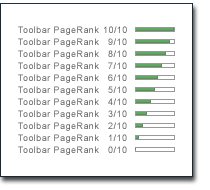
The Google Toolbar displays PageRank on a scale from 0 to 10. First of all, the PageRank of an actually visited page can be estimated by the width of the green bar within the display. If the user holds his mouse over the display, the Toolbar also shows the PageRank value. Caution: The PageRank display is one of the advanced features of the Google Toolbar. And if those advanced features are enabled, Google collects usage data. Additionally, the Toolbar is self-updating and the user is not informed about updates. So, Google has access to the user's hard drive.
If we take into account that PageRank can theoretically have a maximum value of up to dN+(1-d), where N is the total number of web pages and d is usually set to 0.85, PageRank has to be scaled for the display on the Google Toolbar. It is generally assumed that the scalation is not linearly but logarithmically. At a damping factor of 0.85 and, therefore, a minimum PageRank of 0.15 and at an assumed logaritmical basis of 6 we get a scalation as follows:
| Toolbar-PR | Tatsächlicher PR | ||
| 0/10 | 0.15 | - | 0.9 |
| 1/10 | 0.9 | - | 5.4 |
| 2/10 | 5.4 | - | 32.4 |
| 3/10 | 32.4 | - | 194.4 |
| 4/10 | 194.4 | - | 1,166.4 |
| 5/10 | 1,166.4 | - | 6,998.4 |
| 6/10 | 6,998.4 | - | 41,990.4 |
| 7/10 | 41,990.4 | - | 251,942.4 |
| 8/10 | 251,942.4 | - | 1,511,654.4 |
| 9/10 | 1,511,654.4 | - | 9,069,926.4 |
| 10/10 | 9,069,926.4 | - | 0.85 × N + 0.15 |
It is uncertain if in fact a logarithmical scalation in a strictly mathematical sense takes place. There is likely a manual scalation which follows a logarithmical scheme, so that Google has control over the number of pages within the single Toolbar PageRank ranges. The logarithmical basis for this scheme should be between 6 and 7, which can for instance be rudimentary deduced from the number of inbound links of pages with a high Toolbar PageRank from pages with a Toolbar PageRank higher than 4, which are shown by Googe using the link command.
The Toolbar's PageRank Files
Even webmasters who do not want to use the Google Toolbar or the Internet Explorer permanently for security and privacy concerns have the possibility to check the PageRank values of their pages. Google submits PageRank values in simple text files to the Toolbar. In former times, this happened via XML. The switch to text files occured in August 2002.
The PageRank files can be requested directly from the domain www.google.com. Basically, the URLs for those files look like follows (without line breaks):
http://www.google.com/search?client=navclient-auto&
ch=0123456789&features=Rank&q=info:http://www.domain.com/
ch=0123456789&features=Rank&q=info:http://www.domain.com/
There is only one line of text in the PageRank files. The last cipher in this line is PageRank.
The parameters incorporated in the above shown URL are inevitable for the display of the PageRank files in a browser. The value "navclient-auto" for the parameter "client" identifies the Toolbar. Via the parameter "q" the URL is submitted. The value "Rank" for the parameter "features" determines that the PageRank files are requested. If it is omitted, Google's servers still transmit XML files. The parameter "ch" transfers a checksum for the URL to Google, whereby this checksum can only change when the Toolbar version is updated by Google.
Thus, it is necessary to install the Toolbar at least once to find out about the checksum of one's URLs. To track the communication between the Toolbar and Google, often the use of packet sniffers, local proxies an similar tools is suggested. But this is not necessarily needed, since the PageRank files are cached by the Internet Explorer. So, the checksums can simply been found out by having a look at the folder Temporary Internet Files. Knowing the checksums of your URLs, you can view the PageRank files in your browser and you do not have to accept Google's 36 years lasting cookies.
Since the PageRank files are kept in the browser cache and, thus, are clearly visible, and as long as requests are not automated, watching the PageRank files in a browser should not be a violation of Google's Terms of Service. However, you should be cautious. The Toolbar submits its own User-Agent to Google. It is:
Mozilla/4.0 (compatible; GoogleToolbar 1.1.60-deleon; OS SE 4.10)
1.1.60-deleon is a Toolbar version which may of course change. OS is the operating system that you have installed. So, Google is able to identify requests by browsers, if they do not go out via a proxy and if the User-Agent is not modified accordingly.
Taking a look at IE's cache, one will normally notice that the PageRank files are not requested from the domain www.google.com but from IP addresses like 216.239.33.102. Additionally, the PageRank files' URLs often contain a parameter "failedip" that is set to values like "216.239.35.102;1111" (Its function is not absolutely clear). The IP addresses are each related to one of Google's seven data centers and the reason for the Toolbar querying IP-addresses is most likely to control the PageRank display in a better way, especially in times of the "Google Dance".
The PageRank Display at the Google Directory
Webmasters who do not want to check the PageRank files that are used by the toolbar have another possibility to receive information about the PageRank of their sites by means of the Google Directory (directory.google.com).
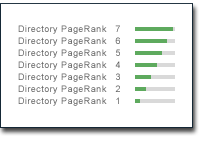
The Google Directory is a dump of the Open Directory Project (dmoz.org), which shows the PageRank for listed documents similarly to the Google Toolbar display scaled and by means of a green bar. In contrast to the Toolbar, the scale is from 1 to 7. The exact value is not displayed, but it can be determined by the divided bar respectively the width of the single graphics in the source code of the page if one is not sure by looking at the bar.
By comparing the Toolbar PageRank of a document with its Directory PageRank, a more exact estimation of a pages PageRank can be deduced, if the page is listed with the ODP. This connection was mentioned first by Chris Raimondi (www.searchnerd.com/pagerank).

Especially for pages with a Toolbar PageRank of 5 or 6, one can appraise if the page is on the upper or the lower end of its Toolbar scale. It shall be noted that for the comparison the Toolbar PageRank of 0 was not taken into account. It can easily be verified that this is appropriate by looking at pages with a Toolbar PageRank of 3. However, it has to be considered that for a verification pages of the Google Directory respectively the ODP with a Toolbar PageRank of 4 or lower have to be chosen, since otherwise no pages linked from there with a Toolbar PageRank of 3 will be found.
What is PageRank Algorithm???
The original PageRank algorithm was described by Lawrence Page and Sergey Brin in several publications. It is given by
PR(A) = (1-d) + d (PR(T1)/C(T1) + ... + PR(Tn)/C(Tn))
where
 | PR(A) is the PageRank of page A, |
 | PR(Ti) is the PageRank of pages Ti which link to page A, |
 | C(Ti) is the number of outbound links on page Ti and |
 | d is a damping factor which can be set between 0 and 1. |
So, first of all, we see that PageRank does not rank web sites as a whole, but is determined for each page individually. Further, the PageRank of page A is recursively defined by the PageRanks of those pages which link to page A.
The PageRank of pages Ti which link to page A does not influence the PageRank of page A uniformly. Within the PageRank algorithm, the PageRank of a page T is always weighted by the number of outbound links C(T) on page T. This means that the more outbound links a page T has, the less will page A benefit from a link to it on page T.
The weighted PageRank of pages Ti is then added up. The outcome of this is that an additional inbound link for page A will always increase page A's PageRank.
Finally, the sum of the weighted PageRanks of all pages Ti is multiplied with a damping factor d which can be set between 0 and 1. Thereby, the extend of PageRank benefit for a page by another page linking to it is reduced.
The Random Surfer Model
In their publications, Lawrence Page and Sergey Brin give a very simple intuitive justification for the PageRank algorithm. They consider PageRank as a model of user behaviour, where a surfer clicks on links at random with no regard towards content.
The random surfer visits a web page with a certain probability which derives from the page's PageRank. The probability that the random surfer clicks on one link is solely given by the number of links on that page. This is why one page's PageRank is not completely passed on to a page it links to, but is devided by the number of links on the page.
So, the probability for the random surfer reaching one page is the sum of probabilities for the random surfer following links to this page. Now, this probability is reduced by the damping factor d. The justification within the Random Surfer Model, therefore, is that the surfer does not click on an infinite number of links, but gets bored sometimes and jumps to another page at random.
The probability for the random surfer not stopping to click on links is given by the damping factor d, which is, depending on the degree of probability therefore, set between 0 and 1. The higher d is, the more likely will the random surfer keep clicking links. Since the surfer jumps to another page at random after he stopped clicking links, the probability therefore is implemented as a constant (1-d) into the algorithm. Regardless of inbound links, the probability for the random surfer jumping to a page is always (1-d), so a page has always a minimum PageRank.
A Different Notation of the PageRank Algorithm
Lawrence Page and Sergey Brin have published two different versions of their PageRank algorithm in different papers. In the second version of the algorithm, the PageRank of page A is given as
PR(A) = (1-d) / N + d (PR(T1)/C(T1) + ... + PR(Tn)/C(Tn))
where N is the total number of all pages on the web. The second version of the algorithm, indeed, does not differ fundamentally from the first one. Regarding the Random Surfer Model, the second version's PageRank of a page is the actual probability for a surfer reaching that page after clicking on many links. The PageRanks then form a probability distribution over web pages, so the sum of all pages' PageRanks will be one.
Contrary, in the first version of the algorithm the probability for the random surfer reaching a page is weighted by the total number of web pages. So, in this version PageRank is an expected value for the random surfer visiting a page, when he restarts this procedure as often as the web has pages. If the web had 100 pages and a page had a PageRank value of 2, the random surfer would reach that page in an average twice if he restarts 100 times.
As mentioned above, the two versions of the algorithm do not differ fundamentally from each other. A PageRank which has been calculated by using the second version of the algorithm has to be multiplied by the total number of web pages to get the according PageRank that would have been caculated by using the first version. Even Page and Brin mixed up the two algorithm versions in their most popular paper "The Anatomy of a Large-Scale Hypertextual Web Search Engine", where they claim the first version of the algorithm to form a probability distribution over web pages with the sum of all pages' PageRanks being one.
In the following, we will use the first version of the algorithm. The reason is that PageRank calculations by means of this algorithm are easier to compute, because we can disregard the total number of web pages.
The Characteristics of PageRank
The characteristics of PageRank shall be illustrated by a small example.
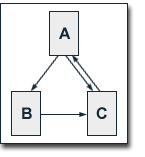
We regard a small web consisting of three pages A, B and C, whereby page A links to the pages B and C, page B links to page C and page C links to page A. According to Page and Brin, the damping factor d is usually set to 0.85, but to keep the calculation simple we set it to 0.5. The exact value of the damping factor d admittedly has effects on PageRank, but it does not influence the fundamental principles of PageRank. So, we get the following equations for the PageRank calculation:
PR(A) = 0.5 + 0.5 PR(C)
PR(B) = 0.5 + 0.5 (PR(A) / 2)
PR(C) = 0.5 + 0.5 (PR(A) / 2 + PR(B))
These equations can easily be solved. We get the following PageRank values for the single pages:
PR(A) = 14/13 = 1.07692308
PR(B) = 10/13 = 0.76923077
PR(C) = 15/13 = 1.15384615
It is obvious that the sum of all pages' PageRanks is 3 and thus equals the total number of web pages. As shown above this is not a specific result for our simple example.
For our simple three-page example it is easy to solve the according equation system to determine PageRank values. In practice, the web consists of billions of documents and it is not possible to find a solution by inspection.
The Iterative Computation of PageRank
Because of the size of the actual web, the Google search engine uses an approximative, iterative computation of PageRank values. This means that each page is assigned an initial starting value and the PageRanks of all pages are then calculated in several computation circles based on the equations determined by the PageRank algorithm. The iterative calculation shall again be illustrated by our three-page example, whereby each page is assigned a starting PageRank value of 1.
| Iteration | PR(A) | PR(B) | PR(C) |
| 0 | 1 | 1 | 1 |
| 1 | 1 | 0.75 | 1.125 |
| 2 | 1.0625 | 0.765625 | 1.1484375 |
| 3 | 1.07421875 | 0.76855469 | 1.15283203 |
| 4 | 1.07641602 | 0.76910400 | 1.15365601 |
| 5 | 1.07682800 | 0.76920700 | 1.15381050 |
| 6 | 1.07690525 | 0.76922631 | 1.15383947 |
| 7 | 1.07691973 | 0.76922993 | 1.15384490 |
| 8 | 1.07692245 | 0.76923061 | 1.15384592 |
| 9 | 1.07692296 | 0.76923074 | 1.15384611 |
| 10 | 1.07692305 | 0.76923076 | 1.15384615 |
| 11 | 1.07692307 | 0.76923077 | 1.15384615 |
| 12 | 1.07692308 | 0.76923077 | 1.15384615 |
We see that we get a good approximation of the real PageRank values after only a few iterations. According to publications of Lawrence Page and Sergey Brin, about 100 iterations are necessary to get a good approximation of the PageRank values of the whole web.
Also, by means of the iterative calculation, the sum of all pages' PageRanks still converges to the total number of web pages. So the average PageRank of a web page is 1. The minimum PageRank of a page is given by (1-d). Therefore, there is a maximum PageRank for a page which is given by dN+(1-d), where N is total number of web pages. This maximum can theoretically occur, if all web pages solely link to one page, and this page also solely links to itself.
Friday, January 7, 2011
Great Firefox Plugins for SEO
I’m a fan of Firefox mainly for the additional functionality you get from using plugins. In fact, it’s always frustrating when I am on someone else’s computer, and I don’t have access to my own set of “tools” that I use on a daily basis. Simply put, if you aren’t using Firefox, you’re missing out on a more effective way to work.
Below is a list of some of my favorite SEO plugins. I have also included a short list of web developer plugins that have some crossover into SEO. I know there are other tools out there, so if you have some additional plugins you like to use, please add them in the comments!
Plugins Specifically for SEO
 SEO for Firefox
SEO for FirefoxThis one is a standard tool for most of the SEOs that I personally know. This plugin gives you a ton of additional information when you do a search on Google. You can see a site’s PageRank, age, Yahoo links and other data that can help you when analyzing your competitors.
It also gives you access to a handy little tool called SEO XRay. This sub-tool will show you the meta information, H tag use and internal and external links on a page. There are so many ways to use SEO for Firefox, it’s no wonder that it’s a standard tool! Aaron Wall (SEOBook) did a great job with this one!
Get it here: SEO for Firefox

Rank Checker
This is another great tool from Aaron Wall. If all you want to do is a quick ranking update, Rank Checker is the way to go. This tool is usually quick, and you can export your findings to a CSV document if you want to compare them with previous rankings.
As with any rank checking tool, it is not always 100% accurate. However, it is still a great free way to keep up on all of your keywords.
Get it here: Rank CheckerSearchStatus
Do you ever get tired of the Google Toolbar? If you’re like me, the only reason you really use the Google Toolbar is to find out the PageRank of the page. Well, with SearchStatus, you can get PageRank, Alexa Rank, Moz Rank and Compete Rank in your status bar. There are many other things that this tool does, but that’s what I mainly use it for.
Get it here: SearchStatus
SEO Link Analysis
I consider this plugin to be one of the essentials in my toolbox. This tool works when you go to the Yahoo Site Explorer or into your Google Webmaster account looking for back links. Rather than just seeing what sites are linking back, you can see the anchor text and the PageRank of the page linking back. You can also find out if the link is still there or has a no follow attribute.
This tool is great for spying on your competition. Go to the Yahoo Site Explorer and you will very quickly find out what keywords your competition is targeting. This makes it great for site analysis and competitive analysis.
Get it here: SEO Link Analysis
Helpful Web Development Plugins
If you’re going to do SEO, you need to know some of the basics of web development as well. Because of this, I thought it might be helpful to list a few plugins that you can use mainly for web development, but also have a crossover into SEO

Firebug
I have loved this plugin ever since I first found it. As an SEO, I find that I am constantly helping to fix web development problems as part of the job. This tool will let you go through a site and find the different elements so you can see where the problems are in the HTML or CSS of the page. You can also make changes to a live site to see what would happen if you tweaked certain things.
Get it here: Firebug
HTML Validator
By having your HTML valid, your site is more likely to look the same in the different browsers. This tool will show you where the problems are in your code that could be causing inconsistencies from browser to browser. It also gives you suggestions on how to fix them.
Get it here: HTML ValidatorWeb Developer
This tool has similar functionality to some of the other tools above and is very handy. I use it frequently to turn off JavaScript so I can see how a site is handling its main navigation. Most web developers that I know of use this plugin.
Get it here: Web Developer
Chrome Extensions for Blogging & SEO
Chrome Extensions for Blogging & SEO ,I’ve converted, but my first experience with Google Chrome occurred about a year ago and it was not a positive one. It was disappointing and frustrating. However, after fighting with Firefox, which crashed many times daily and demanded updates that slowed browsing and constantly interrupted me, I gave Chrome a second chance.
My biggest concern was the lack of extensions (“plugins” for Firefox users), but after about an hour on the Google Chrome Extensions site, that was no longer a problem. So, I’ve compiled a list of the best Chrome Extensions for SEO and a few other can’t-live-without extensions (in no particular order).
1. Chrome SEO

Includes page, backlink, traffic and rank stats, and more.
[download & install now]2. SEO Site Tools

Includes internal and external page data, social media stats, server information and more.
[download & install now]
3. Google Similar Pages beta (by Google)

Shows pages similar to the Web page you’re currently browsing.
[download & install now]4. Domain Details

Shows domain, website and server details at a glance.
[download & install now]5. PageRank

Shows Google PageRank on your toolbar.
[download & install now]6. SeoQuake

Appears to be based on the Firefox plugin (currently in beta).
[download & install now]7. Speed Tracer (by Google)

Shows page performance data.
[download & install now]8. Ultimate Chrome Flag

Get domain, page and server data as well as PageRank and the hosting country’s flag icon.
[download & install now]9. SEO Playground

Shows great on-page content information.
[download & install now]10. Whois+

Get Whois, DNS, Email and Ping information for the current domain.
[download & install now]11. Firebug Lite

Great for front-end inspection of the Web page you’re browsing.
[download & install now]12. Pendule

Web developer tools for Chrome.
[download & install now]13. IMG Inspector

Converts image links to a full gallery with thumbnails. Lightbox-style.
[download & install now]14. Image Preview

Replaces image and video links with a lightbox preview popup.
[download & install now]15. IE Tab

Display web pages using IE in a tab.
[download & install now]
16. MeasureIt!

Draw a ruler to measure any Web page element.
[download & install now]
17. Web Developer Mini
Web developer tools. This is a miniature toolset. Pendule has more functionality.[download & install now]
18. ProxyThisPage

Load the page through a proxy.
[download & install now]19. Switch HTTP Proxy
Switch proxy setting with one click.[download & install now]
20. Session Buddy

Chrome session management.
[download & install now]21. Session Manager

Save sessions of your opened tabs to quickly re-open whenever you like.
[download & install now]22. ShowIP

Displays your current IP address.
[download & install now]
23. AutoPagerize for Chrome

Auto-loads the next page as you scroll through a Web page. For example: Google SERPs, Delicious bookmarks, etc.
[download & install now]24. Evernote Web Clipper

Save interesting stuff you see on the Web into your Evernote account for use on the Web or mobile.
[download & install now]25. My Shortcuts

Quickly access your Google Apps, or custom URLs, that you frequently use.
[download & install now]26. Resolution Test

Test web pages in different resolution settings or set your own resolution.
[download & install now]27. FlashBlock

Block all Flash on all pages or use the whitelist manager to allow certain pages to display Flash.
[download & install now]28. Docs PDF/PowerPoint Viewer (by Google)

Preview PDFs, PowerPoint documents and other docs in Google Docs viewer.
[download & install now]29. WOT (Web of Trust)

A safe browsing tool that warns of malicious sites.
[download & install now]30. AutoPager Chrome

Automatically loads the next page for multi-page sites by just scrolling with your mouse.
[download & install now]31. html2pdf
Converts HTML pages to PDF with one click.
[download & install now]32. Auto Copy

Highlight text and it’s automatically copied to your clipboard.
[download & install now]
33. Chrome Gestures
Create mouse gestures to perform certain tasks.
[download & install now]34. Clickable Links

URLs and Emails displayed in text will be automatically converted to a link.
[download & install now]35. Tab Switch Plus

Find tabs in this vertical tab list and easily switch to new tabs or close immediately.
[download & install now]36. Xmarks Bookmarks Sync

Backup and sync your bookmarks across computers and browsers.
[download & install now]37. Translation Bar

Translate Web pages into your language of choice.
[download & install now]38. Autocomplete = on

Use to remember your passwords. Can be turned off.
[download & install now]39. RoboForm Online

Manage your passwords with RoboForm.
[download & install now]40. LastPass

Manage your password with LastPass.
[download & install now]41. RightLink
Right-click on links will automatically open the link in a new tab.
[download & install now]42. goo.gl URL Shortener

Shorten URLs with goo.gl
[download & install now]
43. StayFocusd

Limit the amount of time you spend on certain sites so you can focus.
[download & install now]44. New Tabs Always Last
Always opens new tabs to the far right of your toolbar. The default in Chrome is to open new tabs directly to the right of the current tab.[download & install now]
45. Search Box

Easily search in multiple search engines.
[download & install now]46. Feedly

Organize your feeds into a magazine-style start page.
[download & install now]47. Search the Current Site

Performs a site search for the current domain rather than just a page find search.
[download & install now]
48. SendTo Extension

Send current Web page to several Internet services: Gmail, Facebook, Twitter, Delicious, WordPress, PDF Online, etc.
[download & install now]49. RemindMe

Set yourself reminders that can be synced on multiple machines.
[download & install now]50. Tabs to the Front!
Opens new tabs and brings them to the front for immediate attention.
[download & install now]51. Aviary Screen Capture

Take a screen capture and edit it immediately with Aviary tools.
[download & install now]52. Picnik Extension for Chrome

Capture a screen image and edit immediately using Picnik tools. Also pulls images from online at Flickr, MySpace, etc.
[download & install now]53. Pixlr Grabber

Grab the entire page or just a section and save it to your desktop or edit using Pixlr tools.
[download & install now]54. Webpage Screenshot

Capture the whole page or sections of the page in a JPG format.
[download & install now]55. Zemanta

Support for many blogging platforms: WordPress, Blogger, Typepad, etc. Associates images, video and other content to be inserted into your blog post as you write.
[download & install now]56. Bit.ly

Easily shorten and share links with Bit.ly.
[download & install now]57. Twitter Reactions

Shows tweets about the current Web page.
[download & install now]
58. Shareaholic for Google Chrome

Share the Web page on your favorite social network.
[download & install now]59. Digg for Chrome

Easily Digg the latest story and find out what is being discovered at the moment.
[download & install now]
60. StumbleUpon

Manage your Stumbles and discover new pages.
[download & install now]61. Del.icio.us Extension

One-click submission to bookmark your current Web page.
[download & install now]62. Delicious Tools

Manage your Delicious account, use a pop-up window for tagging and keyboard shortcuts are available.
[download & install now]63. Chromelicious

Easy access to your tags, bookmarks and Delicious account management.
[download & install now]64. My Alerts

Receive alerts for Twitter, Google, Backtweets, etc.
[download & install now]65. Facebook for Google Chrome

Quickly post status updates and view your wall and news feeds.
[download & install now]66. HootSuite
Manage your Twitter accounts easily. Based on the Firefox plugin.
[download & install now]67. Yelp Mobile for Google Chrome
Manage your Yelp account.
[download & install now]68. Auto HD for YouTube
Will automatically redirect to the HD version, if available, and play as normal.
[download & install now]69. Incredible StartPage
Customize your start page to include shortcuts and recover closed tabs. Also take notes as you browse.
[download & install now]70. Chrome Reader
Subscribe to feeds, in Google Reader, from the address bar.
[download & install now]71. BetterPandora
Who says you don’t need music to do SEO and blog?
[download & install now]Docs PDF/PowerPoint Viewer (by Google)
Subscribe to:
Posts (Atom)
